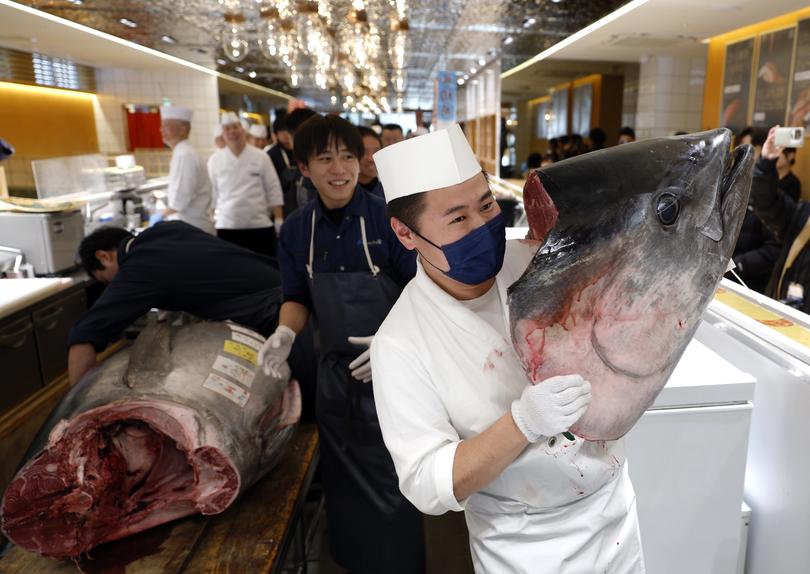Tuna weighing as much as a grizzly bear sells for $1.3 million in Japan
A bluefin tuna sold for $2 million at a predawn auction in Tokyo on Sunday morning, making it one of the most expensive tuna to be sold in the history of sushi.
The 275kg fish, equivalent in weight to a typical male grizzly bear, was caught off the coast of Oma in northern Japan’s Aomori prefecture on Saturday morning, according to Japan’s Kyodo News agency.
The fish was sold to a Michelin-starred Japanese sushi restaurant chain for 207 million yen, the Onodera Group said in a statement about its winning bid.
Sign up to The Nightly's newsletters.
Get the first look at the digital newspaper, curated daily stories and breaking headlines delivered to your inbox.
By continuing you agree to our Terms and Privacy Policy.The first auction of the year at Tokyo’s Toyosu Market - one of the world’s largest wholesale fish markets - typically reels in eye-watering prices.
Japanese public broadcaster NHK reported that the auction began shortly after 5 a.m., with frozen and fresh tuna attracting bids from the country and around the world. This year, the prize tuna fetched over $2,100 per pound - making for some extremely expensive sashimi slices.
“It was as fat as a cow,” 73-year-old fisherman Masahiro Takeuchi told reporters in Oma, Kyodo News reported, recalling the moment he saw the giant tuna caught on a longline.
Onodera said it bought the fish with the cooperation of seafood wholesaler Yamayuk and intends to make it available on sushi menus at 13 of its restaurants. It marked the fifth consecutive year in which the sushi group won the auction, it added.
Photographs showed sushi chefs hauling the gigantic fish onto a sushi counter and preparing the tuna into slices to be served at a Tokyo branch of the Onodera sushi chain.
Oma tuna, a form of Pacific bluefin, is highly prized by sushi restaurateurs as the “black diamond” of tuna fish. A diet of squid and fatty saury fish, combined with its colder-water habitat, gives the tuna a unique balance of fat that makes it a favored sashimi ingredient.
The fish is typically caught in the Tsugaru Strait - a channel frequented by tuna traveling between the Sea of Japan and the Pacific Ocean - using traditional pole and line methods rather than a trawling net, the most popular method for catching Pacific Bluefin. Oma’s tourist board describes itself as “Japan’s Most Famous Tuna Town.”

In 2019, a 278kg Oma tuna fish at the same Tokyo market fetched $4.9 million, making it the most expensive fish to be sold since records began in 1999.
Pacific Bluefin tuna are among the world’s largest and fastest fish, migrating back and forth from the shores of Japan to California in one of Earth’s most remarkable migratory journeys for its sheer scope.
In 2017, Japan was among the tuna-fishing nations to reach a historic agreement imposing strict quotas on fishing of the species, after overfishing caused its population to dwindle to less than 3 percent of historical highs.
According to global fishery bodies, those international efforts paid off - and the Pacific bluefin species is making something of a comeback.
In 2022, the most recent year for which data was available, the International Seafood Sustainability Foundation found that Pacific bluefin had been restored to almost one-quarter of its unfished levels - exceeding a target of 20 percent set by regulators for the year 2034.
According to NOAA Fisheries in the United States, fishing limits on Pacific bluefin have allowed younger fish to multiply and for the stock to recover faster than anticipated.
© 2025 , The Washington Post
